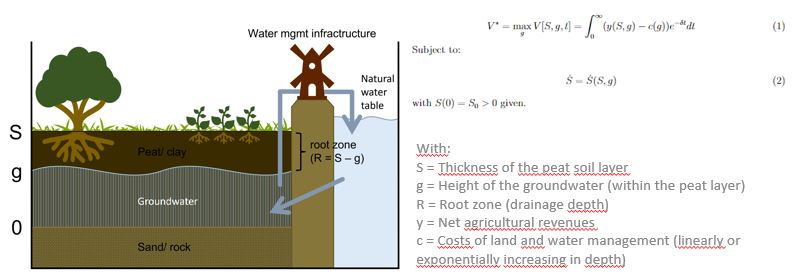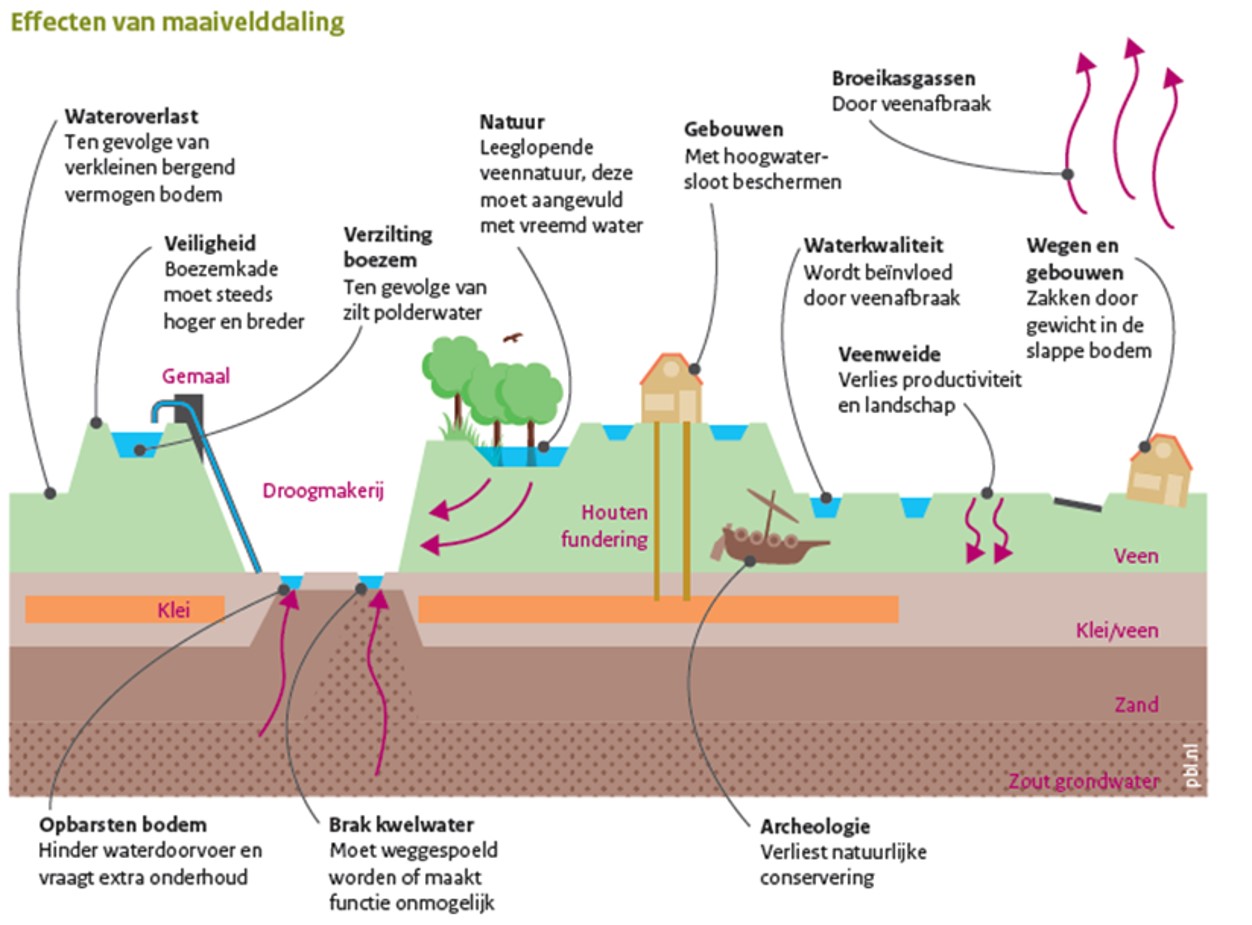WP3.3 – An economic analysis of soil subsidence mitigation
This work package aims to provide economic assessments of management and policy responses to land subsidence. In this project, we aim to translate the impacts of subsidence into costs for society and evaluate potential solution paths regarding its costs and benefits.
An economic optimization model for land subsidence mitigation
From an economic perspective, we are interested in optimizing the use of the resources available. In tackling subsidence, there is an intertemporal trade-off between the costs caused by subsidence (infrastructure damages, increased water and flood management efforts, CO2 emissions and loss of valuable soils) on the one hand and the costs associated with preventing subsidence on the other. The clearest example of this trade-off can be found in the peat grasslands of the West and the North of the Netherlands: To keep the subsiding peat soils dry enough for intensive agricultural production, groundwater levels are lowered, but this lowering speeds up the subsidence process, requiring further groundwater lowering, further depleting the soil layer and increasing costs due to subsidence. To counteract this process, the water levels can be raised. This would immediately result in lower land productivity – it comes at a short-term cost – but it would postpone greater productivity losses in the future and avoid future costs.
Therefore we are interested in two questions when planning for the future management of subsidence: To which extent should we avoid subsidence and when should we take measures (i.e. what is the timing) to maximize the net benefits for society?
To this end, we are currently working on a bio-economic optimization model that maps the dynamics between subsidence, groundwater levels, agricultural yields and costs for water management for an isolated plot of peat grassland. We can use this model to calculate the optimal management strategy by means of water level adjustments over a long time horizon, given local parameter values. In this model, we apply the principles of optimal control theory, which is a mathematical optimization technique used to derive control policies, and is widely applied in the field of natural resource economics.

Figure 1: Schematic overview of the simplest optimization model and cross section of the model plot.
The current model (figure 1) is a strongly simplified version of the real situation. However, the first results provide valuable insights into under what circumstances (regarding soil composition, cost levels, agricultural practices) it is optimal to heighten groundwater levels, slowing down subsidence, to which degree we should do so and what the optimal time path would be. Our results show that both the pure time trade-off between short-term and long-term production losses, as well as increasing water management costs, can be rationales for slowing down land subsidence over time, even when we disregard the social damage costs of subsidence normally considered the main reason for subsidence mitigation.
The next step in our project is to expand the model, for example by including and valuing CO2 emissions, as this is an important motivation in rural areas to combat land subsidence. The goal is to be able to apply this model to the Netherlands by means of spatial data, and calculate potential welfare losses if policy makers would deviate from the optimal policy derived by the model. Through this, we can hopefully provide valuable input to efficient long-term policy options for the mitigation of land subsidence.
Social Cost-Benefit Analysis
In the second stage of this research project we will integrate new insights from the wider LOSS-project on physical subsidence processes (W.P. 2), the effectiveness of technical mitigation measures (W.P. 4.1) and urban damage assessments (W.P. 3.2) into a comprehensive social cost-benefit analysis (SCBA). The goal is to map out the social costs and benefits for a number of policy scenarios for subsidence management that arise from the project (in collaboration with partners and stakeholders) and consist of a set of measures in both rural and urban areas with a clear implementation time-path.
This SCBA will not only assess financial costs (such as for water management, possible loss of agricultural production, damage to buildings), but also broader social costs, such as greenhouse gas emissions, biodiversity, health effects and the historical and recreational value of the landscape (figure 2). In order to deal with a number of uncertainties, we will also have to work on risk estimates and scenarios, such as for damage to buildings and infrastructure due to subsidence and the risk of flooding, in order to weigh these properly in the costs.

Figure 2: Overview of societal effects of land subsidence in the Dutch context which need to be considered in cost-benefit analysis. Source: Van den Born et al., 2016
In order to contribute to the reconciliation of conflicting interests different stakeholders, the forecasting goes beyond aggregated costs and benefits as provided by conventional cost-benefit analyses. Explicit accounting for costs and benefits for each stakeholder subgroup, provides scope to explore cooperation and compensation. In addition the research will develop models to distinguish the costs between regions and urban and rural areas.
Staff and contact
This PhD project started in March 2021 and is conducted by Dewy Verhoeven (WUR), under supervision of Hans-Peter Weikard (WUR) and Suphi Sen (WUR).
For questions or requests related to this project, please contact Dewy Verhoeven:
Email: dewy.verhoeven@wur.nl
LinkedIn: www.linkedin.com/in/dewyverhoeven

